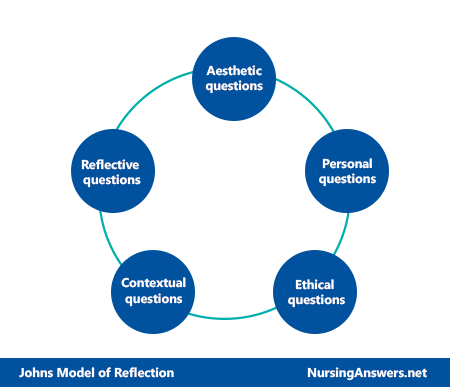Introduction
Like the Gibbs and Rolfe models, Christopher Johns' work on reflective practice was originally developed in a nursing context, but has since become widely applied across a variety of disciplines, including education. Johns' approach to reflective practice has become influential, not least because it provokes a consideration in the individual of matters which are external to them as well as elements which are internal to the practitioner.
The Processes of Johns Model of Reflection
There are two sets of related processes in this model; looking in, then looking outwards.
1. Looking in
First, the practitioner is asked to look inwards upon themselves and recall the experience being analysed. It may be useful to write notes to clarify one's memories. Write a descriptive account of the situation, paying attention to the emotions conjured up in the moment of the event being reflected upon, and those emotions and other thoughts which have been provoked since. Take note of issues arising from the event and its consequences.
2. Looking out
The looking out element of the model is structured around five key sets of questions. The diagram below indicates the working of Johns' model:

2.1. Aesthetic questions
Aesthetics in the sense in which Johns is using it means questions raised in relation to one's sensory perceptions, rather than in the more common usage of referring to an appreciation of art and beauty (Oxford Dictionaries, 2016a). For Johns, aesthetic questions include:
- What was I trying to do?
- What did I react in the ways that I did?
- What were the repercussions for myself / for others?
- How did others feel?
- How did I know what others felt?
2.2. Personal questions
Personal questions relate to self-examination, and ask if you can identify the nature of your actions and reactions, and the elements which influenced or provoked those. Relevant questions to ask here include:
- What internal factors influenced my actions?
- How was I feeling at the time of the event?
- Why was I feeling this way?
2.3. Ethical questions
Ethical questions in this model relate to the coherence of your actions when compared to your moral and professional codes. Was how you acted consistent with your sense of self, and the values which you usually embody? Relevant questions to ask may include:
- To what extent did my actions in this instance match my wider beliefs?
- Was I acting in an uncharacteristic way?
- If so, what elements came together to influence me to act in a way contrary to my usual behaviours, or at odds with my sense of ethics?
- Did I act with best intentions?
2.4. Contextual questions
The contextual element of the model asks you to consider if there were environmental or other factors acting on you from outside. Relevant questions to ask here include:
- What outside influences were a work?
- Were those influences reasonable?
- Who or what informed my actions?
- Would I have acted differently with alternative outside information?
- How might I work to act more positively in the future for the benefit of all?
- How have I changed because of this event?
2.5. Reflective questions
Some versions of Johns' model refer to this section as asking empirical questions; the word 'empirical' in this usage meaning being based on evidence, observation, and experimentation. The process of working through the reflective cycle has generated evidence based upon your observations, and that leads you to be able to make assessments. Relevant questions to ask here can include:
- How does this event compare with other similar ones?
- What could I have done differently?
- What might have been the outcomes of such alternative approaches? Consider this regarding yourself, other colleagues, and the learner/s.
- What are my feelings about the event now?
Evaluation
Johns' model is useful in that it encourages reflection taking into consideration a range of standpoints, and that the reflector is provoked to consider the impacts of their actions not only on other people, but on themselves in respect of their own values. However, the model may be of limited use in some contexts as it is focused on the analysis of specific individual events rather than on wider questions.
The approach may be of relevance to troubleshooting problematic sessions or encounters with learners that went wrong in some way, but the model assumes a context of good practice to contrast the behaviour being reflected upon. The model has a narrative aspect to it, timelining events and feelings towards those events, but there is the danger that if applied superficially, the model may only lead to obvious and descriptive findings.
Cite This Work
To export a reference to this article please select a referencing style below:

